+ データを開く
データを開く
- 基本情報
基本情報
| 登録情報 | データベース: PDB / ID: 7t10 | ||||||
|---|---|---|---|---|---|---|---|
| タイトル | CryoEM structure of somatostatin receptor 2 in complex with somatostatin-14 and Gi3 | ||||||
 要素 要素 |
| ||||||
 キーワード キーワード | MEMBRANE PROTEIN/SIGNALING PROTEIN / GPCR / Receptor / Complex / MEMBRANE PROTEIN / MEMBRANE PROTEIN-SIGNALING PROTEIN complex | ||||||
| 機能・相同性 |  機能・相同性情報 機能・相同性情報somatostatin signaling pathway / dynorphin receptor activity / response to acrylamide / regulation of saliva secretion / MECP2 regulates transcription of neuronal ligands / sensory perception of temperature stimulus / positive regulation of eating behavior / somatostatin receptor activity / adenylate cyclase-inhibiting opioid receptor signaling pathway / hormone-mediated apoptotic signaling pathway ...somatostatin signaling pathway / dynorphin receptor activity / response to acrylamide / regulation of saliva secretion / MECP2 regulates transcription of neuronal ligands / sensory perception of temperature stimulus / positive regulation of eating behavior / somatostatin receptor activity / adenylate cyclase-inhibiting opioid receptor signaling pathway / hormone-mediated apoptotic signaling pathway / G protein-coupled opioid receptor activity / negative regulation of luteinizing hormone secretion / G protein-coupled opioid receptor signaling pathway / peristalsis / positive regulation of dopamine secretion / sensory perception / positive regulation of potassium ion transmembrane transport / conditioned place preference / negative regulation of adenylate cyclase activity / maternal behavior / receptor serine/threonine kinase binding / neuropeptide binding / response to acidic pH / hyperosmotic response / GTP metabolic process / cellular response to glucocorticoid stimulus / response to steroid hormone / positive regulation of p38MAPK cascade / G protein-coupled dopamine receptor signaling pathway / eating behavior / neuronal dense core vesicle / regulation of postsynaptic membrane neurotransmitter receptor levels / response to starvation / behavioral response to cocaine / G protein-coupled receptor signaling pathway, coupled to cyclic nucleotide second messenger / positive regulation of macroautophagy / estrous cycle / GABA-ergic synapse / Adenylate cyclase inhibitory pathway / neuropeptide signaling pathway / response to amino acid / MECP2 regulates neuronal receptors and channels / axon terminus / forebrain development / regulation of cell migration / sensory perception of pain / digestion / T-tubule / adenylate cyclase-inhibiting G protein-coupled receptor signaling pathway / Peptide ligand-binding receptors / cerebellum development / response to nutrient / sarcoplasmic reticulum / locomotory behavior / cellular response to estradiol stimulus / PDZ domain binding / G protein-coupled receptor binding / cellular response to glucose stimulus / response to nicotine / G-protein beta/gamma-subunit complex binding / Olfactory Signaling Pathway / response to insulin / Activation of the phototransduction cascade / adenylate cyclase-modulating G protein-coupled receptor signaling pathway / G beta:gamma signalling through PLC beta / Presynaptic function of Kainate receptors / Thromboxane signalling through TP receptor / G-protein activation / G protein-coupled acetylcholine receptor signaling pathway / Activation of G protein gated Potassium channels / Inhibition of voltage gated Ca2+ channels via Gbeta/gamma subunits / hormone activity / Prostacyclin signalling through prostacyclin receptor / Glucagon signaling in metabolic regulation / G beta:gamma signalling through CDC42 / ADP signalling through P2Y purinoceptor 12 / G beta:gamma signalling through BTK / Synthesis, secretion, and inactivation of Glucagon-like Peptide-1 (GLP-1) / Sensory perception of sweet, bitter, and umami (glutamate) taste / synaptic vesicle membrane / photoreceptor disc membrane / Adrenaline,noradrenaline inhibits insulin secretion / Glucagon-type ligand receptors / Vasopressin regulates renal water homeostasis via Aquaporins / G alpha (z) signalling events / cellular response to catecholamine stimulus / Glucagon-like Peptide-1 (GLP1) regulates insulin secretion / ADORA2B mediated anti-inflammatory cytokines production / sensory perception of taste / response to estrogen / ADP signalling through P2Y purinoceptor 1 / adenylate cyclase-activating dopamine receptor signaling pathway / G beta:gamma signalling through PI3Kgamma / cellular response to prostaglandin E stimulus / Cooperation of PDCL (PhLP1) and TRiC/CCT in G-protein beta folding / GPER1 signaling / GDP binding / G-protein beta-subunit binding / Inactivation, recovery and regulation of the phototransduction cascade / heterotrimeric G-protein complex 類似検索 - 分子機能 | ||||||
| 生物種 |  Homo sapiens (ヒト) Homo sapiens (ヒト) | ||||||
| 手法 | 電子顕微鏡法 / 単粒子再構成法 / クライオ電子顕微鏡法 / 解像度: 2.5 Å | ||||||
 データ登録者 データ登録者 | Robertson, M.J. / Skinotis, G. | ||||||
| 資金援助 | 1件
| ||||||
 引用 引用 |  ジャーナル: Nat Struct Mol Biol / 年: 2022 ジャーナル: Nat Struct Mol Biol / 年: 2022タイトル: Plasticity in ligand recognition at somatostatin receptors. 著者: Michael J Robertson / Justin G Meyerowitz / Ouliana Panova / Kenneth Borrelli / Georgios Skiniotis /  要旨: Somatostatin is a signaling peptide that plays a pivotal role in physiologic processes relating to metabolism and growth through its actions at somatostatin receptors (SSTRs). Members of the SSTR ...Somatostatin is a signaling peptide that plays a pivotal role in physiologic processes relating to metabolism and growth through its actions at somatostatin receptors (SSTRs). Members of the SSTR subfamily, particularly SSTR2, are key drug targets for neuroendocrine neoplasms, with synthetic peptide agonists currently in clinical use. Here, we show the cryogenic-electron microscopy structures of active-state SSTR2 in complex with heterotrimeric G and either the endogenous ligand SST14 or the FDA-approved drug octreotide. Complemented by biochemical assays and molecular dynamics simulations, these structures reveal key details of ligand recognition and receptor activation at SSTRs. We find that SSTR ligand recognition is highly diverse, as demonstrated by ligand-induced conformational changes in ECL2 and substantial sequence divergence across subtypes in extracellular regions. Despite this complexity, we rationalize several known sources of SSTR subtype selectivity and identify an additional interaction for specific binding. These results provide valuable insights for structure-based drug discovery at SSTRs. | ||||||
| 履歴 |
|
- 構造の表示
構造の表示
| ムービー |
 ムービービューア ムービービューア |
|---|---|
| 構造ビューア | 分子:  Molmil Molmil Jmol/JSmol Jmol/JSmol |
- ダウンロードとリンク
ダウンロードとリンク
- ダウンロード
ダウンロード
| PDBx/mmCIF形式 |  7t10.cif.gz 7t10.cif.gz | 206.1 KB | 表示 |  PDBx/mmCIF形式 PDBx/mmCIF形式 |
|---|---|---|---|---|
| PDB形式 |  pdb7t10.ent.gz pdb7t10.ent.gz | 161.1 KB | 表示 |  PDB形式 PDB形式 |
| PDBx/mmJSON形式 |  7t10.json.gz 7t10.json.gz | ツリー表示 |  PDBx/mmJSON形式 PDBx/mmJSON形式 | |
| その他 |  その他のダウンロード その他のダウンロード |
-検証レポート
| 文書・要旨 |  7t10_validation.pdf.gz 7t10_validation.pdf.gz | 806.1 KB | 表示 |  wwPDB検証レポート wwPDB検証レポート |
|---|---|---|---|---|
| 文書・詳細版 |  7t10_full_validation.pdf.gz 7t10_full_validation.pdf.gz | 810.7 KB | 表示 | |
| XML形式データ |  7t10_validation.xml.gz 7t10_validation.xml.gz | 33.8 KB | 表示 | |
| CIF形式データ |  7t10_validation.cif.gz 7t10_validation.cif.gz | 52.9 KB | 表示 | |
| アーカイブディレクトリ |  https://data.pdbj.org/pub/pdb/validation_reports/t1/7t10 https://data.pdbj.org/pub/pdb/validation_reports/t1/7t10 ftp://data.pdbj.org/pub/pdb/validation_reports/t1/7t10 ftp://data.pdbj.org/pub/pdb/validation_reports/t1/7t10 | HTTPS FTP |
-関連構造データ
| 関連構造データ |  25586MC  7t11C M: このデータのモデリングに利用したマップデータ C: 同じ文献を引用 ( |
|---|---|
| 類似構造データ | |
| 電子顕微鏡画像生データ |  EMPIAR-10931 (タイトル: Cryogenic electron microscopy of somatostatin receptor 2/SST14/Gi3 complex EMPIAR-10931 (タイトル: Cryogenic electron microscopy of somatostatin receptor 2/SST14/Gi3 complexData size: 4.5 TB Data #1: Raw movies of SSTR2/SST14/Gi3 complex collected on a K3 [micrographs - multiframe]) |
- リンク
リンク
- 集合体
集合体
| 登録構造単位 | 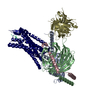
|
|---|---|
| 1 |
|
- 要素
要素
-Guanine nucleotide-binding protein ... , 3種, 3分子 ABC
| #2: タンパク質 | 分子量: 40584.156 Da / 分子数: 1 / Mutation: S47N, G203A, E245A, A326S / 由来タイプ: 組換発現 / 詳細: dominant negative / 由来: (組換発現)  Homo sapiens (ヒト) / 遺伝子: GNAI3 / 発現宿主: Homo sapiens (ヒト) / 遺伝子: GNAI3 / 発現宿主:  Trichoplusia ni (イラクサキンウワバ) / 参照: UniProt: P08754 Trichoplusia ni (イラクサキンウワバ) / 参照: UniProt: P08754 |
|---|---|
| #3: タンパク質 | 分子量: 37671.102 Da / 分子数: 1 / 由来タイプ: 組換発現 / 由来: (組換発現)  Homo sapiens (ヒト) / 遺伝子: GNB1 / 発現宿主: Homo sapiens (ヒト) / 遺伝子: GNB1 / 発現宿主:  Trichoplusia ni (イラクサキンウワバ) / 参照: UniProt: P62873 Trichoplusia ni (イラクサキンウワバ) / 参照: UniProt: P62873 |
| #4: タンパク質 | 分子量: 7861.143 Da / 分子数: 1 / 由来タイプ: 組換発現 / 由来: (組換発現)  Homo sapiens (ヒト) / 遺伝子: GNG2 / 発現宿主: Homo sapiens (ヒト) / 遺伝子: GNG2 / 発現宿主:  Trichoplusia ni (イラクサキンウワバ) / 参照: UniProt: P59768 Trichoplusia ni (イラクサキンウワバ) / 参照: UniProt: P59768 |
-タンパク質 / タンパク質・ペプチド / 抗体 / 非ポリマー , 4種, 8分子 RPS

| #1: タンパク質 | 分子量: 45784.211 Da / 分子数: 1 / 由来タイプ: 組換発現 詳細: Somatostatin receptor type 2 with intracellular loop 3 (ICL3) replaced with the ICL3 from the Kappa-type opioid receptor 由来: (組換発現)  Homo sapiens (ヒト) / 遺伝子: SSTR2, OPRK1, OPRK Homo sapiens (ヒト) / 遺伝子: SSTR2, OPRK1, OPRK発現宿主:  参照: UniProt: P30874, UniProt: P41145 |
|---|---|
| #5: タンパク質・ペプチド | 分子量: 1641.909 Da / 分子数: 1 / 由来タイプ: 合成 / 由来: (合成)  Homo sapiens (ヒト) / 参照: UniProt: P61278 Homo sapiens (ヒト) / 参照: UniProt: P61278 |
| #6: 抗体 | 分子量: 27784.896 Da / 分子数: 1 / 由来タイプ: 組換発現 / 由来: (組換発現)  発現宿主:  |
| #7: 水 | ChemComp-HOH / |
-実験情報
-実験
| 実験 | 手法: 電子顕微鏡法 |
|---|---|
| EM実験 | 試料の集合状態: PARTICLE / 3次元再構成法: 単粒子再構成法 |
- 試料調製
試料調製
| 構成要素 | 名称: Somatostatin receptor 2 in complex with Somatostatin-14 and Gi3. タイプ: COMPLEX / Entity ID: #1-#6 / 由来: MULTIPLE SOURCES |
|---|---|
| 緩衝液 | pH: 7.5 |
| 試料 | 包埋: NO / シャドウイング: NO / 染色: NO / 凍結: YES |
| 急速凍結 | 凍結剤: ETHANE |
- 電子顕微鏡撮影
電子顕微鏡撮影
| 実験機器 |  モデル: Titan Krios / 画像提供: FEI Company |
|---|---|
| 顕微鏡 | モデル: FEI TITAN KRIOS |
| 電子銃 | 電子線源:  FIELD EMISSION GUN / 加速電圧: 300 kV / 照射モード: OTHER FIELD EMISSION GUN / 加速電圧: 300 kV / 照射モード: OTHER |
| 電子レンズ | モード: BRIGHT FIELD |
| 撮影 | 電子線照射量: 1.04 e/Å2 / フィルム・検出器のモデル: GATAN K3 (6k x 4k) |
- 解析
解析
| CTF補正 | タイプ: PHASE FLIPPING AND AMPLITUDE CORRECTION |
|---|---|
| 3次元再構成 | 解像度: 2.5 Å / 解像度の算出法: FSC 0.143 CUT-OFF / 粒子像の数: 442863 / 対称性のタイプ: POINT |
 ムービー
ムービー コントローラー
コントローラー




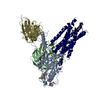
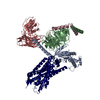
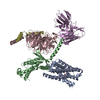
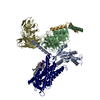
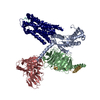

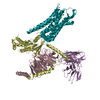
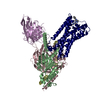


 PDBj
PDBj



























